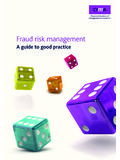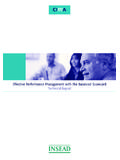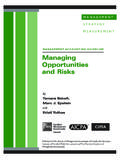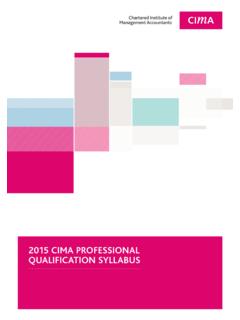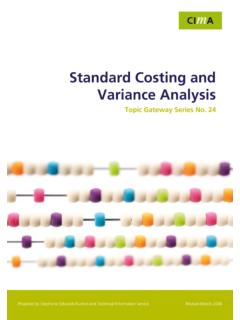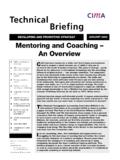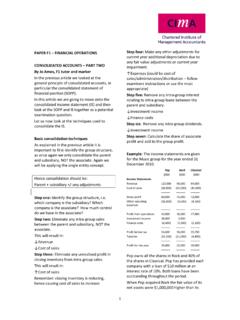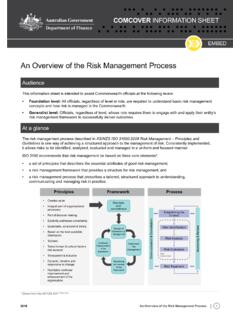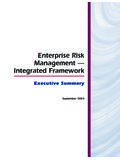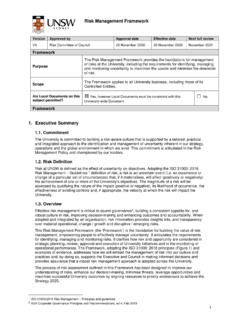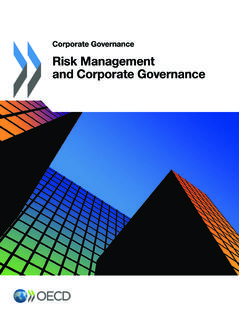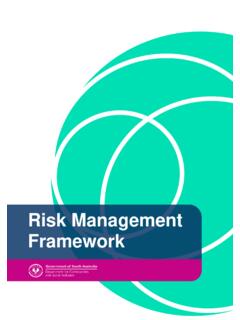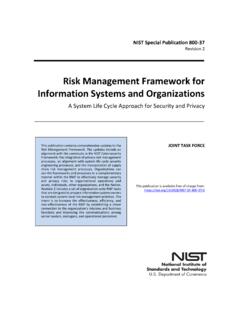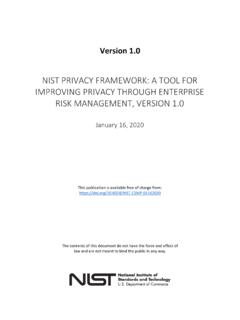Transcription of Enterprise Risk Management - Chartered Institute of ...
1 Enterprise Risk Management Topic Gateway Series 1 Prepared by Jasmin Harvey and Technical Information Service July 2008 Enterprise Risk Management Topic Gateway Series No. 49 Enterprise Risk Management Topic Gateway Series About Topic Gateways Topic Gateways are intended as a refresher or introduction to topics of interest to CIMA members. They include a basic definition, a brief overview and a fuller explanation of practical application. Finally they signpost some further resources for detailed understanding and research. Topic Gateways are available electronically to CIMA members only in the CPD Centre on the CIMA website, along with a number of electronic resources. About the Technical Information Service CIMA supports its members and students with its Technical Information Service (TIS) for their work and CPD needs.
2 Our information and accounting specialists work closely together to identify or create authoritative resources to help members resolve their work related information needs. Additionally, our accounting specialists can help CIMA members and students with the interpretation of guidance on financial reporting, financial Management and performance Management , as defined in the CIMA Official Terminology 2005 edition. CIMA members and students should sign into My CIMA to access these services and resources. 2 The Chartered Institute of Management Accountants 26 Chapter Street London SW1P 4NP United Kingdom T. +44 (0)20 7663 5441 F. +44 (0)20 7663 5442 E. Enterprise Risk Management Topic Gateway Series 3 Definition and concept Enterprise Risk Management (ERM) can be defined as the.
3 Process effected by an entity s board of directors, Management and other personnel, applied in strategy setting and across the Enterprise , designed to identify potential events that may affect the entity, and manage risk to be within its risk appetite, to provide reasonable assurance regarding the achievement of entity objectives. Enterprise Risk Management Integrated framework , the Committee of Sponsoring Organisations, COSO, 2004 The CIMA Official Terminology uses the COSO (Committee of Sponsoring Organisations) definition. However, there is no universally agreed definition and the COSO definition is just one of a number of definitions developed for Enterprise Risk Management . For example, see the Australian/New Zealand Risk Management Standard 4360. Some research indicates that ERM is still a rather elusive and under-specified concept . Although ERM has been discussed at length by professionals in the field, little progress seems to have been made in achieving this elusive nirvana.
4 Managing Business Risk, 5th ed., page 30 Differing terminology, methodology and measures means that ERM in practice will differ across industries and organisations. What is important for ERM to be effective is that an organisation s interpretation and use of ERM terminology, methodology and measures is consistent within that organisation. Context In the current syllabus, ERM is core to the syllabus for P3 Management Accounting Risk and Control Strategy of the professional qualification. Students must understand Enterprise risk Management and will be examined on it. In the CIMA Professional Development framework , ERM is found under Governance ERM. Related concepts Risk Management ; Enterprise wide risk Management ; internal control. Enterprise Risk Management Topic Gateway Series 4 Overview In the last decade, risk Management has transformed from the traditional silo approach practised by individual departments and functions to a holistic, co-ordinated and integrated process which manages risk throughout the organisation.
5 This integrated approach has become known as ERM. Enterprise wide means the removal of traditional functional, divisional, departmental or cultural barriers. Enterprise Risk Management , KMPG, page 2 A number of drivers have contributed to increased emphasis on risk awareness and the need for a co-ordinated, Enterprise wide approach. Drivers include globalisation, the increased complexity of doing business, regulatory compliance/corporate governance developments, and greater accountability for the board and senior Management to increase shareholder value. These drivers mean that an organisation and its board must have a thorough understanding of the key risks affecting the organisation and what is being done to manage them. ERM offers a framework to provide this understanding and also to integrate risk Management in decision making activity throughout the organisation.
6 Underlying principles of ERM The key underlying principles of ERM include: consideration in the context of business strategy it is everyone s responsibility, with the tone set from the top a focused strategy, led by the board active Management of risk creation of a risk aware culture a comprehensive and holistic approach to risk Management consideration of a broad range of risks (strategic, financial, operational and compliance) implementation through a risk Management framework or system. Enterprise Risk Management Topic Gateway Series 5 Application Development of a risk strategy The purpose of developing a risk strategy is to articulate clearly how risk should be approached in an organisation. A risk strategy is important to embed risk within the organisation s culture. Such a strategy must be consistent with and reviewed alongside the organisation s business strategy.
7 Key elements to include are: a statement of the value proposition specific to the organisation the agreed risk appetite of the organisation (see below for a definition of risk appetite) agreed objectives for risk Management based on the organisation s objectives and business strategy a statement of the organisation s cultural approach to risk details of who owns risk Management at various levels within the organisation reference to the risk Management framework or system details of performance evaluation for monitoring the effectiveness of the risk Management framework . Adapted from Enterprise Governance Executive Report, CIMA ERM frameworks ERM is a term used by COSO which published the COSO Enterprise Risk Management Integrated framework in 2004. This has become a well known framework on how to implement ERM. COSO was not the first to publish practical guidance on an Enterprise wide approach to risk Management .
8 The first edition of the joint Australian/New Zealand Standard for Risk Management was published in 1995. A further edition, published in 1999, provides guidance on how to establish and implement an Enterprise wide risk Management process. Enterprise Risk Management Topic Gateway Series In 2001, KMPG published a report titled Enterprise Risk Management : an emerging model for building shareholder value. This report puts forward an ERM framework where risk strategy is built around and supports the organisation s business strategy and objectives. It is important to understand that there is no one methodology that should be followed by an organisation. Two examples are given below for illustration. 1. KPMG The KPMG framework maintains that ERM and its strategy should be intrinsically linked to an organisation s business strategy. Risk portfolio development, risk optimisation, and measuring and monitoring take place in the context of strategies based on an ERM structure.
9 This ensures that risk Management is embedded in the organisation s structure. Source: Enterprise Risk Management : an emerging model for building shareholder value, A KPMG White Paper, KPMG, November 2001. 6 Enterprise Risk Management Topic Gateway Series 2. COSO ERM framework Source: COSO (2004) Enterprise Risk Management Integrated framework The COSO ERM framework is presented here in more detail to introduce some key risk terms. It comprises a three dimensional matrix in the form of a cube which reflects the relationships between four objectives, seven components and four different organisational levels. The four objectives are: strategic (high level goals, aligned with and supporting the organisation s mission) operations (efficient and effective use of resources) reporting (reliability of reporting) compliance (compliance with laws and regulations). These categories may be the responsibility of different executives across the entity and address different needs.
10 Responsibility for different objectives and related risks needs to be clearly articulated and communicated. The necessary resources must be defined for each organisational level, including each business unit. Integrating risk Management into strategy, performance Management , training and development, and budgetary processes helps to assign responsibilities. 7 Enterprise Risk Management Topic Gateway Series 8 The COSO framework identifies eight components which must function effectively for risk Management to be successful. The eight interrelated components are: 1. Internal environment This is the tone of the organisation, including the risk Management philosophy and risk appetite. Risk Management philosophy is the general attitude or approach an organisation takes in dealing with risks . Risk appetite is level of risk that a company can undertake and successfully manage over an extended time period.
